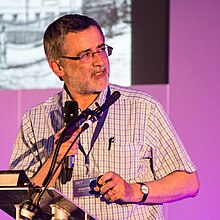Richard Treisman
Sir Richard Treisman | |
|---|---|
 Treisman in 2015 | |
| Born | 7 October 1954[6] |
| Education | Haberdashers' Aske's Boys' School |
| Alma mater | Christ's College, Cambridge University College London |
| Awards |
|
| Scientific career | |
| Institutions | Francis Crick Institute Harvard University University of Cambridge Laboratory of Molecular Biology |
| Thesis | The structures of polyoma virus-specific nuclear and cytoplasmic RNA molecules (1981) |
| Doctoral advisor | Bob Kamen[4] |
| Other academic advisors | Tom Maniatis |
| Notable students | Richard Marais[5] |
| Website | www |
Sir Richard Henry Treisman (born 7 October 1954)[6] is a British scientist specialising in the molecular biology of cancer. Treisman is a director of research at the Francis Crick Institute in London.
Education
[edit]Treisman was educated at Haberdashers' Aske's Boys' School[6] and Christ's College, Cambridge, where he was awarded a Bachelor of Arts degree in 1977.[6] He completed his postgraduate study at the Imperial Cancer Research Fund (ICRF) and University College London, where he was awarded a PhD for research on polyomavirus transcription and RNA processing supervised by Bob Kamen[4] in 1981.[7]
Career and research
[edit]After his PhD, Treisman pursued postdoctoral research at Harvard University on globin gene expression and thalassemia genes with Tom Maniatis. In 1984, he joined the Medical Research Council (MRC) Laboratory of Molecular Biology (LMB) at the University of Cambridge, where he started working on how growth factors control transcription. Initially focusing on the Fos gene, he identified the transcription factor Serum response factor (SRF) and cloned its gene, before returning to London in 1988.[8]
He showed that the TCF family of SRF cofactors are targets for Mitogen-activated protein kinase (MAPK) signalling, and demonstrated that the MRTF transcription cofactors are novel G-actin binding proteins that sense fluctuations in G-actin concentration. He continues to focus on SRF's regulatory cofactors and their cognate signalling pathways.[8]
Treisman was Director of the Cancer Research UK (CRUK) London Research Institute from 2000 to 2015, becoming Research Director of the Francis Crick Institute in 2009.
Awards and honours
[edit]Treisman was elected a member of the European Molecular Biology Organization[when?] and a Fellow of the Academy of Medical Sciences (FMedSci);[when?] he received the EMBO Gold Medal in 1995[9] and the Louis-Jeantet Prize for Medicine in 2002.[2] He was elected a Fellow of the Royal Society (FRS) in 1994 and knighted in the 2016 Birthday Honours.[3][10]
References
[edit]- ^ "EMBO MEMBER: Richard Treisman". people.embo.org.
- ^ a b Louis-Jeantet Prize
- ^ a b "No. 61608". The London Gazette. 11 June 2016. p. B2.
- ^ a b "Voices of the Fifth Floor – Blue Skies and Bench Space". blueskiesbenchspace.org.
- ^ Larue, Lionel (2010). "Richard Marais". Pigment Cell & Melanoma Research. 23 (3): 448. doi:10.1111/j.1755-148X.2010.00708.x. ISSN 1755-1471. PMID 20518862.
- ^ a b c d Anon (2017). "Treisman, Dr Richard Henry". Who's Who (online Oxford University Press ed.). Oxford: A & C Black. doi:10.1093/ww/9780199540884.013.37996. (Subscription or UK public library membership required.)
- ^ Treisman, Richard Henry (1981). The structures of polyoma virus-specific nuclear and cytoplasmic RNA molecules. london.ac.uk (PhD thesis). University College London (University of London). OCLC 556387169. EThOS uk.bl.ethos.290828.
- ^ a b Anon (1994). "Richard Treisman". royalsociety.org. London: Royal Society. Archived from the original on 27 October 2017. Retrieved 27 May 2018. One or more of the preceding sentences incorporates text from the royalsociety.org website where:
"All text published under the heading 'Biography' on Fellow profile pages is available under Creative Commons Attribution 4.0 International License." --Royal Society Terms, conditions and policies at the Wayback Machine (archived 2016-11-11)
- ^ Treisman, Richard (1995). "Journey to the surface of the cell: Fos regulation and the SRE". The EMBO Journal. 14 (20): 4905–4913. doi:10.1002/j.1460-2075.1995.tb00173.x. PMC 394592. PMID 7588619.
- ^ Anon (2016). "Birthday honours: Mitochondrial disease doctor recognised". BBC.
![]() This article incorporates text available under the CC BY 4.0 license.
This article incorporates text available under the CC BY 4.0 license.
